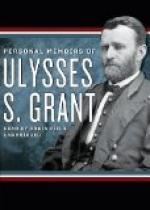Suitable directions will at once be given for all trains and surplus artillery to conform to this movement.
U. S. GRANT.
On the 20th, Lee showing no signs of coming out of his lines, orders were renewed for a left-flank movement, to commence after night.
CHAPTER LIV.
MOVEMENT BY THE LEFT FLANK—BATTLE OF NORTH ANNA—AN INCIDENT OF THE MARCH—MOVING ON RICHMOND—SOUTH OF THE PAMUNKEY—POSITION OF THE NATIONAL ARMY.
We were now to operate in a different country from any we had before seen in Virginia. The roads were wide and good, and the country well cultivated. No men were seen except those bearing arms, even the black man having been sent away. The country, however, was new to us, and we had neither guides nor maps to tell us where the roads were, or where they led to. Engineer and staff officers were put to the dangerous duty of supplying the place of both maps and guides. By reconnoitring they were enabled to locate the roads in the vicinity of each army corps. Our course was south, and we took all roads leading in that direction which would not separate the army too widely.
Hancock who had the lead had marched easterly to Guiney’s Station, on the Fredericksburg Railroad, thence southerly to Bowling Green and Milford. He was at Milford by the night of the 21st. Here he met a detachment of Pickett’s division coming from Richmond to reinforce Lee. They were speedily driven away, and several hundred captured. Warren followed on the morning of the 21st, and reached Guiney’s Station that night without molestation. Burnside and Wright were retained at Spottsylvania to keep up the appearance of an intended assault, and to hold Lee, if possible, while Hancock and Warren should get start enough to interpose between him and Richmond.
Lee had now a superb opportunity to take the initiative either by attacking Wright and Burnside alone, or by following by the Telegraph Road and striking Hancock’s and Warren’s corps, or even Hancock’s alone, before reinforcements could come up. But he did not avail himself of either opportunity. He seemed really to be misled as to my designs; but moved by his interior line—the Telegraph Road—to make sure of keeping between his capital and the Army of the Potomac. He never again had such an opportunity of dealing a heavy blow.
The evening of the 21st Burnside, 9th corps, moved out followed by Wright, 6th corps. Burnside was to take the Telegraph Road; but finding Stanard’s Ford, over the Po, fortified and guarded, he turned east to the road taken by Hancock and Warren without an attempt to dislodge the enemy. The night of the 21st I had my headquarters near the 6th corps, at Guiney’s Station, and the enemy’s cavalry was between us and Hancock. There was a slight attack on Burnside’s and Wright’s corps as they moved out of their lines; but it was easily repulsed. The object probably was only to make sure that we were not leaving a force to follow upon the rear of the Confederates.




